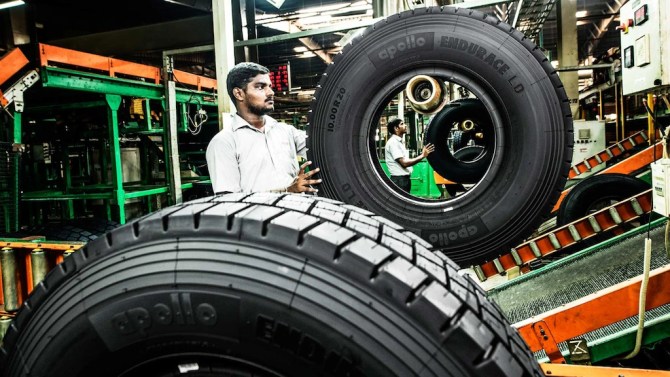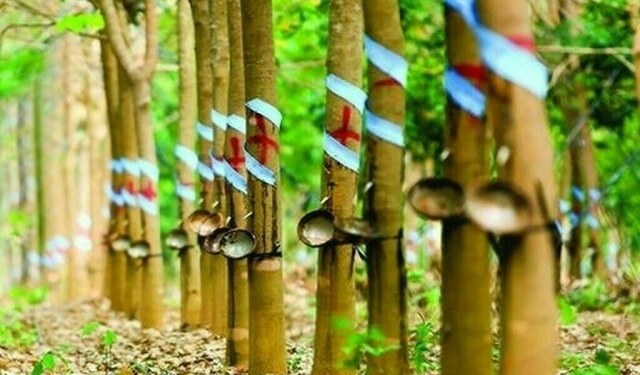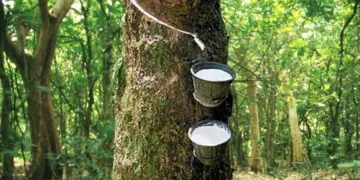While the demand is healthy with the steady expansion of the automobile industry and other major consuming industries, supply of natural rubber globally has been tight. And this upcycle is distinct from previous ones, CRISIL said.

With the price of natural rubber going up, tyre makers are expecting a rough patch going ahead. (Image: IE)
With the price of natural rubber going up by more than 33 per cent on-year in just the first five months of the fiscal year amid strong demand and crunched supply, tyre makers are expecting a rough patch going ahead, stated a report by CRISIL Ratings. Domestic prices of natural rubber closed August at Rs 238 per kg on average, which is way above the trend in the past decade.
The last time the commodity breached the Rs 200/kg mark was in 2011, and the surge in price was propelled by demand recovery after the Global Financial Crisis, aided by the accommodative stance of the US Federal Reserve and other central banks. Prices had logged a compound annual growth rate of 101 per cent between 2008 and 2011. However, the three-year surge did not sustain and for a decade thereafter prices remained subdued below Rs 150 per kg on average.
Now, since the end of 2023, prices have shot up again. While the demand is healthy with the steady expansion of the automobile industry and other major consuming industries, supply of natural rubber globally has been tight. And this upcycle is distinct from previous ones, CRISIL said.
Pushan Sharma, Director-Research, Market Intelligence and Analytics, CRISIL Ratings, said, “While the previous spikes were triggered by isolated events such as farmer protests over low profits in 2016 or the pandemic-induced labour crisis in 2020, the current price rise is rooted in fundamentals, i.e., demand and supply dynamics. In 2011, the natural rubber market had sufficient supply to cater to global demand. Between fiscals 2011 and 2023, however, global production grew 35 per cent, while demand expanded 40 per cent, resulting in supply crunch and, thereby, higher prices.”
That, the report said, has a huge bearing on the profitability of tyre makers as natural rubber is a major input, accounting for 20-40 per cent of the weight of tyres, depending on the category. Indeed, the tyre industry accounts for around 80 per cent of natural rubber consumption in the country.
The margins of tyre original equipment manufacturers (OEMs), therefore, have a negative correlation with prices of natural rubber. In the first quarter of this fiscal, for instance, the operating margin of the top five Indian listed tyre manufacturers declined by around 200 basis points to 14 per cent, compared with 16 per cent in fiscal 2024, as natural rubber prices shot up 22 per cent on-year.
Mohit Adnani, Associate Director- Research, Market Intelligence and Analytics, CRICIL Ratings, said, “With further rise in demand and restricted supply, the prices of natural rubber are expected to remain elevated, impacting the margins of tyre manufacturers well beyond fiscal 2025. The deficit in the natural rubber market is expected to triple in 2024 as smaller tappable area and lower yield, along with a potential increase in demand, test the supply side.”
CRISIL said that while crude prices are expected to ease, leading to a decline in the cost of crude-based raw materials such as styrene butadiene rubber, poly butadiene rubber, carbon black, and nylon tyre cord fabric, the rising cost of natural rubber is likely to drive up its Basic Tyre Raw Material Index, which tracks the prices of these commodities. This fiscal, the index is expected to print 4-6 per cent higher, reversing a 5 per cent decline last fiscal.
In the milieu, it becomes imperative for tyre OEMs to explore ways to mitigate the impact of a prolonged supply shortage, such as developing alternative supplies or reducing costs by exploring imports from cheaper destinations.





























